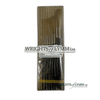How to Store Gold Leaf
- by Sam Wozniak
How to Store Genuine Gold Leaf Properly: Tips from Wrights of Lymm Gold Leaf Tin
If you’ve ever worked with gold leaf, you know how delicate and valuable it is. Whether you’re using it for gilding, monumental restoration, fine art, or crafts, preserving its quality is essential. In this guide, we’ll explore the best practices for storing genuine gold leaf, the traditional Wrights of Lymm gold leaf tin, a staple among professional gilders.
Why Proper Gold Leaf Storage Matters
Goldleaf is incredibly thin—often just a few microns thick. Because of this, it's highly sensitive to environmental factors such as humidity, air movement, and handling. Improper storage can lead to oxidation (if not pure), tears, or contamination with dust and oils, which can compromise your gilding results.
Gilders who work on monumental projects, such as statues, memorials, and architectural details, understand the importance of maintaining the integrity of their materials. The quality of the leaf directly affects the durability and brilliance of the finished piece. That's why learning how to store gold leaf properly is just as important as learning how to apply it.
Inspiration from the Wrights of Lymm Gold Leaf Tin
As one of the oldest and most trusted names in gilding, our specialist team at Wrights of Lymm have been supplying genuine gold leaf to artists and craftsmen for generations. Our iconic gold leaf tins are more than just packaging—they’re purpose-built storage solutions designed to protect and preserve the integrity of goldleaf.
Here’s what makes the Wrights of Lymm gold leaf tin an ideal model for storage:
-
Metal construction: The tin is durable, and shields against light exposure.
-
Compact size: Perfect for storing books of gold leaf without them shifting or becoming damaged.
-
Traditional design: It reflects a deep understanding of what gold leaf needs to stay pristine—minimal air exposure, dryness, and protection from environmental contaminants.
Using a dedicated storage tin like this is an excellent way to extend the lifespan of your gold leaf and maintain its premium quality.
Step-by-Step Guide to Storing Gold Leaf
1. Keep It in Its Original Book or Packet
Always keep your gold leaf in the book it came in. These books are usually made from rouged paper that helps prevent sticking and static cling. They also keep the sheets flat and aligned, reducing the risk of folds or creases.
2. Use a Wrights of Lymm-Style Storage Tin
Transfer your book of goldleaf into the Wrights of Lymm Gold Leaf Storage tin! Ideal for:
-
Reducing air exposure
-
Blocking out moisture
-
Preventing physical damage from bumps or drops
3. Store in a Cool, Dry Place
Humidity is one of the main enemies of genuine gold leaf. Store your tin in a cool, dry place, away from windows, radiators, and damp environments. If possible, use silica gel packets inside your storage area to control moisture levels.
4. Avoid Direct Handling
Oils and moisture from your fingers can tarnish or tear the leaf. Always use gilding tools like a gilder’s knife and tip when handling the leaf. If you must handle it directly, wear cotton gloves.
5. Label and Rotate Stock
If you have multiple books or tins, label them with the type of leaf (e.g 23.5ct goldleaf) and purchase date. Use older stock first to ensure consistent results in your gilding projects.
Pro Tip: Travel-Friendly Storage for Monumental Gilding Projects
If you're taking on a monumental restoration job and need to travel with your materials, tins like the Wrights of Lymm gold leaf tin are ideal. They’re compact and secure enough to be transported without damaging the leaf, making them a top choice for on-site gilding work.
Final Thoughts
Whether you’re a seasoned gilder or just starting out, storing your goldleaf properly is a critical part of your craft. The Wrights of Lymm gold leaf tin provides a tried-and-true method for keeping your gold leaf in pristine condition. By following these simple storage tips, you’ll protect your investment and ensure stunning results in every gilding project—from fine art to monumental restoration.
For more gilding tips and gold leaf insights, be sure to check out our other posts!






